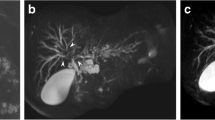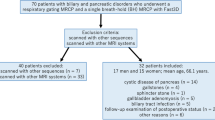Abstract
Objectives
To compare the image quality of three-dimensional breath-hold magnetic resonance cholangiopancreatography with deep learning-based compressed sensing reconstruction (3D DL-CS-MRCP) to those of 3D breath-hold MRCP with compressed sensing (3D CS-MRCP), 3D breath-hold MRCP with gradient and spin–echo (3D GRASE-MRCP) and conventional 2D single-shot breath-hold MRCP (2D MRCP).
Methods
In total, 102 consecutive patients who underwent MRCP at 3.0 T, including 2D MRCP, 3D GRASE-MRCP, 3D CS-MRCP, and 3D DL-CS-MRCP, were prospectively included. Two radiologists independently analyzed the overall image quality, background suppression, artifacts, and visualization of pancreaticobiliary ducts using a five-point scale. The signal-to-noise ratio (SNR) of the common bile duct (CBD), contrast-to-noise ratio (CNR) of the CBD and liver, and contrast ratio between the periductal tissue and CBD were measured. The Friedman test was performed to compare the four protocols.
Results
3D DL-CS-MRCP resulted in improved SNR and CNR values compared with those in the other three protocols, and better contrast ratio compared with that in 3D CS-MRCP and 3D GRASE-MRCP (all, p < 0.05). Qualitative image analysis showed that 3D DL-CS-MRCP had better performance for second-level intrahepatic ducts and distal main pancreatic ducts compared with 3D CS-MRCP (all, p < 0.05). Compared with 2D MRCP, 3D DL-CS-MRCP demonstrated better performance for the second-order left intrahepatic duct but was inferior in assessing the main pancreatic duct (all, p < 0.05). Moreover, the image quality was significantly higher in 3D DL-CS-MRCP than in 3D GRASE-MRCP.
Conclusion
3D DL-CS-MRCP has superior performance compared with that of 3D CS-MRCP or 3D GRASE-MRCP. Deep learning reconstruction also provides a comparable image quality but with inferior main pancreatic duct compared with that revealed by 2D MRCP.
Key Points
• 3D breath-hold MRCP with deep learning reconstruction (3D DL-CS-MRCP) demonstrated improved image quality compared with that of 3D MRCP with compressed sensing or GRASE.
• Compared with 2D MRCP, 3D DL-CS-MRCP had superior performance in SNR and CNR, better visualization of the left second-level intrahepatic bile ducts, and comparable overall image quality, but an inferior main pancreatic duct.




Similar content being viewed by others
Abbreviations
- 2D:
-
Two-dimensional
- 3D:
-
Three-dimensional
- AI:
-
Artificial intelligence
- BH:
-
Breath hold
- CBD:
-
Common bile duct
- CNR:
-
Contrast-to-noise ratio
- CS:
-
Compressed sensing
- DL:
-
Deep learning
- GRASE:
-
Gradient and spin–echo
- MRCP:
-
Magnetic resonance cholangiopancreatography
- ROI:
-
Region of interest
- SD:
-
Standard deviation
- SI:
-
Signal intensity
- SNR:
-
Signal-to-noise ratio
References
Fábrega-Foster K, Ghasabeh MA, Pawlik TM, Kamel IR (2017) Multimodality imaging of intrahepatic cholangiocarcinoma. Hepatobiliary Surg Nutr 6:67–78
Selvaraj EA, Culver EL, Bungay H et al (2019) Evolving role of magnetic resonance techniques in primary sclerosing cholangitis. World J Gastroenterol 25:644–658
Cai L, Yeh BM, Westphalen AC et al (2017) 3D T2-weighted and Gd-EOB-DTPA-enhanced 3D T1-weighted MR cholangiography for evaluation of biliary anatomy in living liver donors. Abdom Radiol (NY) 42:842–850
Chu ML, Chien CP, Wu WC, Chung HW (2019) Gradient- And spin-echo (GRASE) MR imaging: a long-existing technology that may find wide applications in modern era. Quant Imaging Med Surg 9:1477–1484
Nakaura T, Kidoh M, Maruyama N et al (2013) Usefulness of the SPACE pulse sequence at 1.5T MR cholangiography: comparison of image quality and image acquisition time with conventional 3D-TSE sequence. J Magn Reson Imaging 38:1014–1019
Matos C, Cappeliez O, Winant C et al (2002) MR imaging of the pancreas: a pictorial tour. Radiographics 22:e2
Yeh BM, Liu PS, Soto JA et al (2009) MR imaging and CT of the biliary tract. Radiographics 29:1669–1688
Yoon LS, Catalano OA, Fritz S et al (2009) Another dimension in magnetic resonance cholangiopancreatography: comparison of 2- and 3-dimensional magnetic resonance cholangiopancreatography for the evaluation of intraductal papillary mucinous neoplasm of the pancreas. J Comput Assist Tomogr 33:363–368
Chandarana H, Doshi AM, Shanbhogue A et al (2016) Three-dimensional MR cholangiopancreatography in a breath hold with sparsity-based reconstruction of highly undersampled data. Radiology 280:585–594
Chen Z, Sun B, Duan Q et al (2019) Three-dimensional breath-hold MRCP using SPACE pulse sequence at 3 T: comparison with conventional navigator-triggered technique. AJR Am J Roentgenol 213:1247–1252
Yoshida M, Nakaura T, Inoue T et al (2018) Magnetic resonance cholangiopancreatography with GRASE sequence at 3.0 T: does it improve image quality and acquisition time as compared with 3D TSE? Eur Radiol 28:2436–2443
Nam JG, Lee JM, Kang HJ et al (2018) GRASE Revisited: breath-hold three-dimensional (3D) magnetic resonance cholangiopancreatography using a Gradient and Spin Echo (GRASE) technique at 3T. Eur Radiol 28:3721–3728
Chien CP, Chiu FM, Shen YC et al (2020) Magnetic resonance cholangiopancreatography at 3t in a single breath-hold: comparative effectiveness between three-dimensional (3d) gradient- and spin-echo and two-dimensional (2d) thick-slab fast spin-echo acquisitions. Quant Imaging Med Surg 10:1265–1274
Feng L, Benkert T, Block KT et al (2017) Compressed sensing for body MRI. J Magn Reson Imaging 45:966–987
Blaise H, Remen T, Ambarki K et al (2021) Comparison of respiratory-triggered 3D MR cholangiopancreatography and breath-hold compressed-sensing 3D MR cholangiopancreatography at 1.5 T and 3 T and impact of individual factors on image quality. Eur J Radiol 142:109873
Henninger B, Steurer M, Plaikner M et al (2020) Magnetic resonance cholangiopancreatography with compressed sensing at 1.5 T: clinical application for the evaluation of branch duct IPMN of the pancreas. Eur Radiol 30:6014–6021
Li S, Zhou J, Liang D, Liu Q (2020) MRI denoising using progressively distribution-based neural network. Magn Reson Imaging 71:55–68
Zucker EJ, Sandino CM, Kino A et al (2021) Free-breathing accelerated cardiac mri using deep learning: validation in children and young adults. Radiology 300:539–548
Rastogi A, Yalavarthy PK (2020) Comparison of iterative parametric and indirect deep learning-based reconstruction methods in highly undersampled DCE-MR Imaging of the breast. Med Phys 47:4838–4861
Chen F, Taviani V, Malkiel I et al (2018) Variable-density single-shot fast spin-echo MRI with deep learning reconstruction by using variational networks. Radiology 289:366–373
Ueda T, Ikedo M, Ikeda H et al (2022) Deep learning reconstruction of diffusion-weighted MRI improves image quality for prostatic imaging. Radiology 303:373–381
Koch KM, Sherafati M, Arpinar VE et al (2021) Analysis and evaluation of a deep learning reconstruction approach with denoising for orthopedic MRI. Radiol Artif Intell 3:e200278
Pezzotti N, Yousefi S, Elmahdy MS et al (2020) An adaptive intelligence algorithm for undersampled knee MRI reconstruction. IEEE Access 8:204825–204838
Pezzotti N, de Weerdt E, Yousefi S et al (2019) Adaptive-CS-Net: FastMRI with Adaptive Intelligence. Available via https://arxiv.org/pdf/1912.12259.pdf. Accessed 13 Dec 2019
Ronneberger O, Fischer P, Brox T (2015) In: Navab N, Hornegger J, Wells WM, Frangi AF (eds) U-Net: convolutional networks for biomedical image segmentation BT - Medical Image Computing and Computer-Assisted Intervention – MICCAI 2015. Springer International Publishing, Cham, pp 234–241
Lohöfer FK, Kaissis GA, Rasper M et al (2019) Magnetic resonance cholangiopancreatography at 3 Tesla: image quality comparison between 3D compressed sensing and 2D single-shot acquisitions. Eur J Radiol 115:53–58
Yoen H, Lee JM, Lee SM et al (2021) Comparisons between image quality and diagnostic performance of 2D- and breath-hold 3D magnetic resonance cholangiopancreatography at 3T. Eur Radiol 31:8399–8407
Zhu L, Xue H, Sun Z et al (2018) Modified breath-hold compressed-sensing 3D MR cholangiopancreatography with a small field-of-view and high resolution acquisition: Clinical feasibility in biliary and pancreatic disorders. J Magn Reson Imaging 48:1389–1399
Chen Z, Sun B, Xue Y et al (2021) Comparing compressed sensing breath-hold 3D MR cholangiopancreatography with two parallel imaging MRCP strategies in main pancreatic duct and common bile duct. Eur J Radiol 142:109833
Bustin A, Fuin N, Botnar RM, Prieto C (2020) From compressed-sensing to artificial intelligence-based cardiac MRI reconstruction. Front Cardiovasc Med 7:1–19
Jang W, Song JS, Kim SH, Yang J Do (2021) Comparison of compressed sensing and gradient and spin-echo in breath-hold 3d mr cholangiopancreatography: qualitative and quantitative analysis. Diagnostics 11:634
Cristobal-Huerta A, Poot DHJ, Vogel MW et al (2018) K-space trajectories in 3D-GRASE sequence for high resolution structural imaging. Magn Reson Imaging 48:10–19
Park S, Torrisi S, Townsend JD et al (2021) Highly accelerated submillimeter resolution 3D GRASE with controlled T2 blurring in T2-weighted functional MRI at 7 Tesla: a feasibility study. Magn Reson Med 85:2490–2506
Acknowledgements
This work was supported by the 1·3·5 Project for Disciplines of Excellence-Clinical Research Incubation Project, West China Hospital, Sichuan University (ZYGD18019).
Funding
This study has received funding from the 1·3·5 Project for Disciplines of Excellence-Clinical Research Incubation Project, West China Hospital, Sichuan University (ZYGD18019).
Author information
Authors and Affiliations
Corresponding authors
Ethics declarations
Guarantor
The scientific guarantor of this publication is Zhenlin Li.
Conflict of interest
The authors of this manuscript declare relationships with the following companies: Philips Healthcare. One of our authors is an employee of Philips Healthcare. This author only provided technical support and did not have control over the data at any point during the study.
Statistics and biometry
No complex statistical methods were necessary for this paper.
Informed consent
Written informed consent was obtained from all subjects (patients) in this study.
Ethical approval
Institutional Review Board approval was obtained.
Methodology
• prospective
• diagnostic or prognostic study
• performed at one institution
Additional information
Publisher’s note
Springer Nature remains neutral with regard to jurisdictional claims in published maps and institutional affiliations.
Yu Zhang and Wanlin Peng contributed to the work equally.
Rights and permissions
Springer Nature or its licensor (e.g. a society or other partner) holds exclusive rights to this article under a publishing agreement with the author(s) or other rightsholder(s); author self-archiving of the accepted manuscript version of this article is solely governed by the terms of such publishing agreement and applicable law.
About this article
Cite this article
Zhang, Y., Peng, W., Xiao, Y. et al. Rapid 3D breath-hold MR cholangiopancreatography using deep learning–constrained compressed sensing reconstruction. Eur Radiol 33, 2500–2509 (2023). https://doi.org/10.1007/s00330-022-09227-y
Received:
Revised:
Accepted:
Published:
Issue Date:
DOI: https://doi.org/10.1007/s00330-022-09227-y




